Shinkansen and Hiroshima
(Checking departure time)
While speeding in the Hitari (meaning Light as in "speed of light") the shinkansen does, as the world glides by, not feel to be doing a 300 km per hour speed (185 miles). This bullet train is quiet and comfortable with all seats facing forward.
The chairs by the way can pivot around to give a group of 4 or more an option to be together facing each other. At the beginning and end station cleaning crews of 4 per 2 cars move in after bowing to each leaving customer and spic and span the cars in about 5 minutes.
(Sandee poses with our indomitable mrs Hakuro)
Hiroshima is our destination. We want to visit the "Peace Island" and pay respect to the loss of life on August 6, 1945 when at 8:15am "little boy" was dropped from the Enola Gay flattening 60 percent of all buildings in a 3 to 4 km radius about the size of the then 350,000 people city. 70,000 people died instantaneously and 70,000 followed as a result of radiation in a years time. (This was one of the more difficult blogs to write for me as like Auschwitz it ranks as one of the more gruesome events of war among nations especially as it effected so many innocent non combatants. But as Sandee aptly remarked today it felt like the Japanese had turned the event and the memorial into a worldwide peace movement with no rancor towards America. The museum somewhere clearly stated that Japan started the war deliberately against the U.S.)

(A 1914 industrial exposition hall in its original damaged stage being the closest surviving building (160 meters) from hypo center of the blast)
This and many more details were rattled off by our energetic 70 plus year old, 5 foot tall Ms Haruko (last name first) Tamura (given first name last) a free guide we requested months ago.
(Atomic bomb memorial mound under which tens of thousands unidentified victims are buried)
Every Prefecture in Japan has volunteer guide organizations. The guides are most of the time students wishing to practice their English or retirees wishing to spend some time with the still "rare foreign" visitor. Travel expenses are to be reimbursed (Ms Haruko requested 600 yen or 6 dollars) and lunch is appreciated.
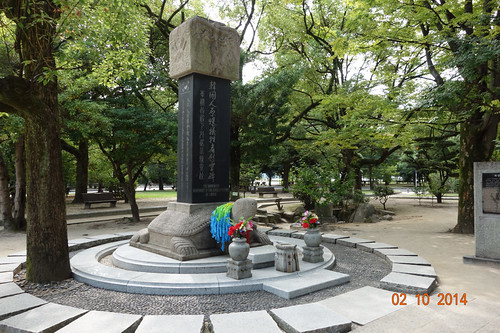
(10,000 Koreans forced to work as slave labor for the Japanese died during the blast. Koreans believe that the turtle will carry you to heaven)
Ms Haruko met us at 9:30am at the hotel and speed-walked us, and I really mean speed-walked us, the next four hours constantly lecturing to and through the Peace Island about half a mile from our hotel situated on Peace Avenue. As a bonus she showed us the Hiroshima Castle on the other side of town after lunch.
(Sadako only got to 664 origami cranes before she passed away)

 (Memorial to the 1000 schoolchildren who died as a result of having been mobilized to "clean up" the bomb site. Adult male workers were unavailable since they were off fighting the war)
(Memorial to the 1000 schoolchildren who died as a result of having been mobilized to "clean up" the bomb site. Adult male workers were unavailable since they were off fighting the war)
(The 2km red epicenter shown here destroyed and killed instantaneously - the city covered a radius of 4 km)
During the walk ms Hakuro told us that her mother worked in the hospital on the 3km perimeter that morning and was flattened to the floor by the blast. She carried glass splinters from a blown out window in her back for the rest of her life which created discomfort in certain situations and positions.
Her father worked for the local government that day on a bridge on the other side of town and was also lucky in that he was apparently on a riverbank below blast level.
Another human story is that her grandmother never saw her other daughter anymore despite the fact that she was purportedly not in town that day, and that she therefore religiously attended the annual ceremony remembering the unidentified victims at the Atomic Bomb Mound, believing her daughter was there.
All in all, with the school children chanting for peace and a museum section dedicated to world peace and an atomic free world, all that gave this day a feeling of hope for a better world.
After lunch story:
The rebuilt Hiroshimo Castle was built in 1589 by the first shogun here. Shogun Mori named the little village that grew after the construction of his home after his father or maybe grandfather "hiro", thus Hiroshima was born.
See below pictures, the main house is five stories high towering above the trees
I had blisters on my feet thanks to ms Haruko. We were grateful for the respite of lunch. A Hiroshima style Okonomiyaki (Japanese pancake, each region claims their own style), which was the size of a pizza and weighed in average 650 grams (23 oz) according to Google, was wolfed down by her with coffee.We both ate half of it and used up our alotted daily calories.
(One finds cemeteries at the strangest places)
By 3 pm we were back on the Shinkansen to Kyoto for our first and most likely only stay in an original Japanese (although westernized - we have a private western style bathroom ) guesthouse, where we will sleep Tatami style on the floor, but enough for now, I'll write about Kyoto later.

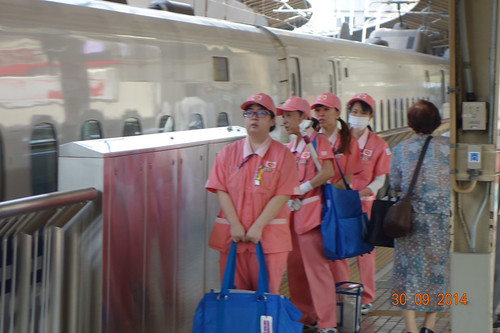
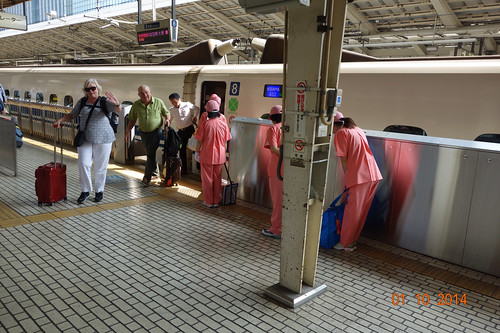

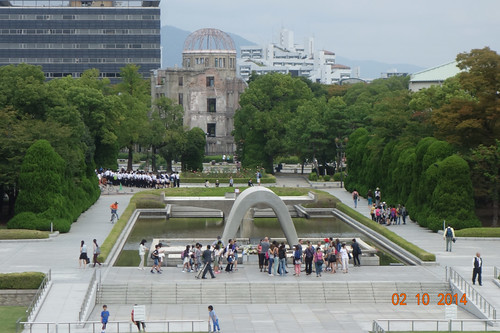















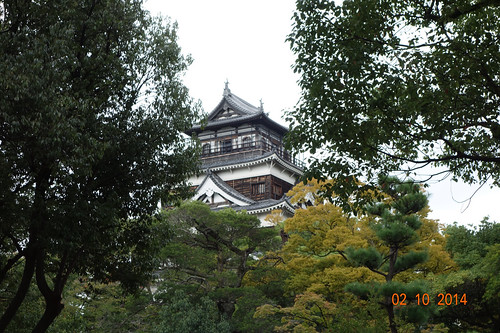


Comments
Post a Comment